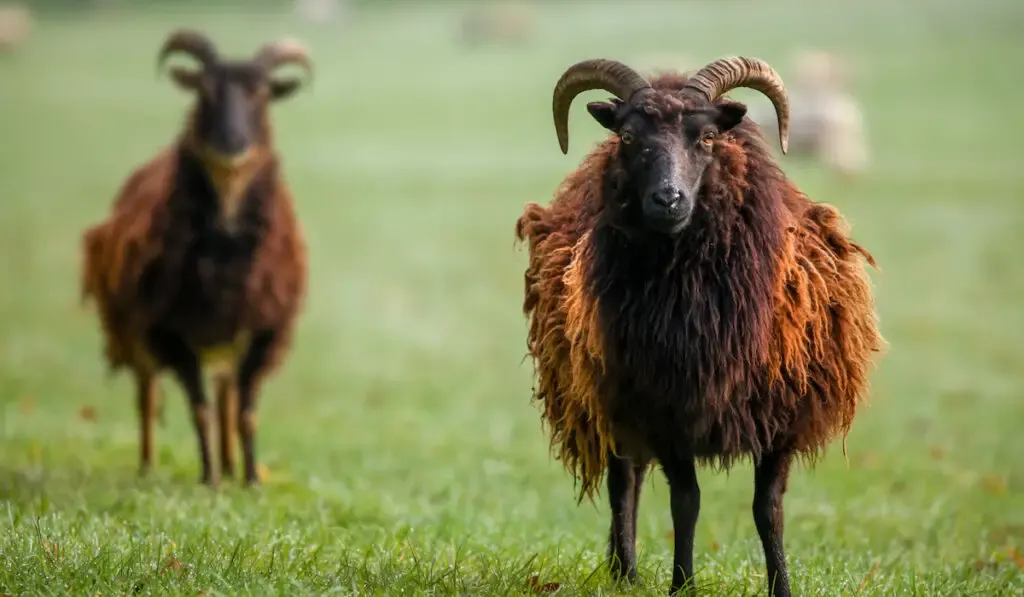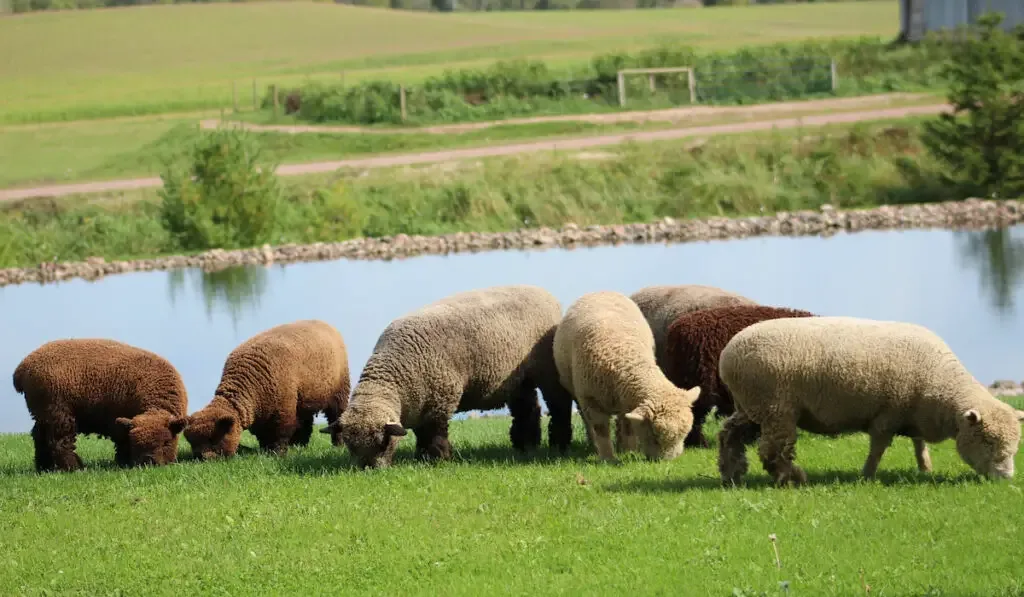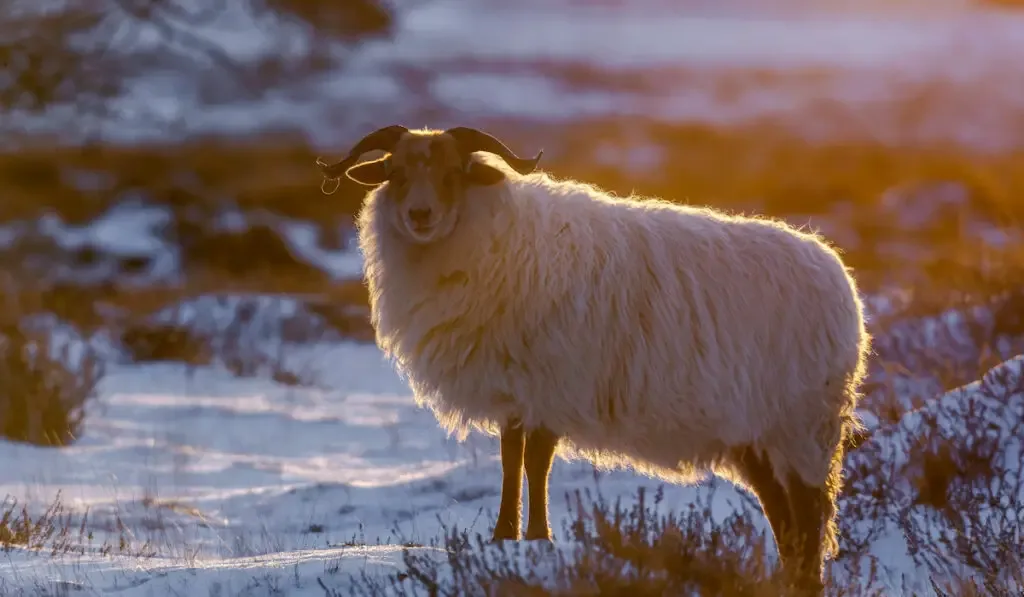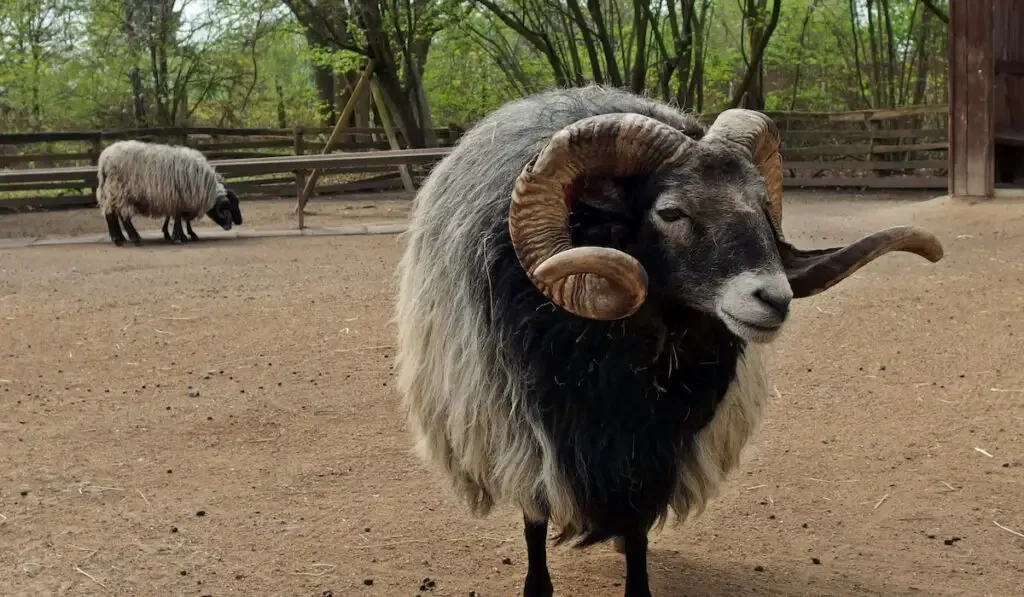Common knowledge tells us that sheep are primarily raised for meat, wool, and milk. But beyond these mainstream purposes, sheep may also be bred for clearing brush and eating weeds.
As with other features of sheep, some breeds are better at vegetation control than others. If you are looking to raise sheep to clear brush and control weeds on your property, you should consider the following breeds:
Alpines Steinschaf

The Alpines Steinschaf is a domestic multi-purpose sheep breed native to southern Germany and the eastern Austrian Alps. It is perhaps the oldest breed of sheep from the eastern Alps.
The Alpine Steinschaf is one of the 4 breeds that form the Steinschaf sheep group and may be the oldest among them.
Though the Steinschaf part of its name is somewhat of a mystery, it is thought that this breed may have origins in the medieval centuries. Its popularity remains high in the Eastern Alps regions it is native to.
Alpines Steinschaf sheep are a wool breed. But their wool typically does not extend to their faces and lower legs.
Generally, Alpines Steinschaf sheep are medium-to-large-sized. The mature rams weigh around 121-176 pounds. On the other hand, the mature ewes weigh between 88 and 132 pounds.
Alpines Steinschaf sheep can be horned or polled. Their coats are available in many colors, and sometimes, they can be dual-colored.
Sheep of this breed are pretty hardy, and they thrive in alpine climates.
As mentioned earlier, Alpines Steinschaf sheep are a multi-purpose breed. While they are raised for meat and wool like many other sheep breeds, they may also be kept for vegetation management.
Hebridean

The Hebridean is a small domestic Scottish sheep breed. It belongs to the Northern European short-tailed sheep group. And as expected, it shares the diminutive size of other members.
Hebridean Sheep may also be referred to as St Kilda Sheep. On average, the mature rams of this breed weigh 110 to 132 pounds. The mature ewes, however, weigh an average of 88 pounds.
Members of the Hebridean Sheep breed come in two colors: gray and black. Both male and female Hebrideans are horned, and they may have 2 or 4 horns.
Those with 4 horns are more common. Hebridean Sheep are wooled, and the only part of their bodies without wool is their legs and face.
They may be small, but the Hebridean Sheep are hardy. They thrive in most climates and are more inclined to browsing.
This is why they are functional in clearing brush and controlling weeds.
Besides vegetation management, Hebridean Sheep are also raised for meat. Notably, Hebridean meat contains lower levels of cholesterol relative to many other common breeds.
It goes without saying, but Hebridean Sheep are also bred for their wool.
Babydoll Southdown Sheep

The Babydoll Southdown sheep is an English breed originating from the South Down of Sussex County. It is one of the oldest down sheep, revered for its tameness and ease of handling.
Sheep of the Babydoll Southdown breed are wooled all over, including their faces and legs. They are typically white or off-white with brown or mousy gray legs. Babydoll Southdown Sheep may also come with black fleece. However, this color may become light gray as the sheep ages.
The average Babydoll Southdown Sheep weighs around 60 to 125 pounds. This makes them a small to medium breed.
Babydoll Southdown Sheep are bred for meat. Their meat is flavorful, and for their small size, they produce a lot of it.
Besides meat, Babydoll Southdown sheep may be raised for wool and for clearing brush and controlling weeds.
St. Croix Sheep
The St. Croix sheep is an American breed with origins tied to the US Virgin Islands. It may also be called White Virgin Island, White Virgin Islander, and Virgin Island White.
St. Croix sheep are medium-sized. While the mature rams average 198 pounds, the ewes weigh around 150 pounds.
St. Croix sheep have no horns. They only come with white coats, which is one of the reasons they were imported into North America.
St. Croix sheep are very hardy; they thrive in all climates and are resistant to many parasites.
St. Croix sheep are primarily raised for meat. But they may also be bred for dairy purposes. Besides meat and milk, St. Croix sheep can be used in vegetation management.
Bentheimer Landschaf

The Bentheimer Landschaf (also called Landrace of Bentheim) is a domestic sheep breed native to Germany. This breed came from a cross between Dutch heath sheep and German heath sheep.
Members of this breed are generally medium-sized. Mature rams of the Bentheimer Landschaf breed weigh around 165 to 176 pounds. The ewes, however, weigh 110 to 132 pounds.
Bentheimer Landschaf sheep come with white coats. They are polled, and they have sturdy hooves and long legs.
Bentheimer Landschaf sheep have the most massive size amongst the breeds of the German heath and moor sheep. They are pretty hardy, and they thrive best in their localized climates.
Bentheimer Landschaf sheep are bred primarily for landscape preservation and vegetation control. However, they may also be raised for their high-quality fleece. Their meat is also pretty delicious, so some breed them for meat.
Coburger Fuchsschaf
The Coburger Fuchsschaf may also be called the Coburger Fox sheep. They are a large-sized sheep breed with origins in Germany.
For obvious reasons, the reddish-brown or golden coat of Coburger Fuchsschaf earned them the name Coburger Fox sheep. This is the only coat color they come in.
On average, a mature Coburger Fuchsschaf ram 176 to 220 pounds. The mature ewes weigh an average of 132 to 165 pounds.
Unlike most other sheep breeds, Coburger Fuchsschaf sheep are primarily raised for landscape preservation and vegetation management.
Coburger Fuchsschaf sheep are highly productive; they can breed as many as 3 times in 2 years. And for each litter, they birth an average of 2 lambs.
Braunes Bergschaf
The Braunes Bergschaf breed goes by a couple of other names. It may also be called the Brown Mountain sheep, the Schwarzbraunes Bergschaf, or the Pecora Nera-Bruna.
This breed is native to the Tyrol area of Italy and Austria. It was created from a cross between the Tyrolean Tiroler Steinschaf and the Italian Bergamasca and Padovana.
Braunes Bergschaf sheep are medium to large-sized. On average, mature Braunes Bergschaf ewes weigh around 132 to 154 pounds. The mature rams weigh 176 to 220 pounds.
Braunes Bergschaf sheep are hardy, and they adapt well to climates closely resembling their native one. Their coats are typically black or brown. However, their wool is brown.
Braunes Bergschaf sheep have no horns. They are raised for meat, milk, wool, and vegetation control.
Drenthe Heath Sheep

The Drenthe heath sheep is a domestic breed from the Netherlands. It also goes by the name Drents Heideschaap.
The Drenthe Heath sheep is one of the oldest European sheep breeds still in existence. It is estimated that they were introduced into Drenthe (currently a province in the Netherlands) around 4000 B.C.
Mature Drenthe Heath ewes typically weigh around 99 pounds, while the rams weigh 110 pounds. The average weight of Drenthe Heath sheep puts them in the small to medium class. While Drenthe Heath rams are always horned, the ewes may be horned or polled.
While Drenthe Heath sheep are hardy, they thrive best in their native climate. They are primarily raised for clearing brush and eating weeds. But they may also be bred for meat.
The meat of the Drenthe Heath sheep is revered for its quality. It is described as being naturally fragrant and is gaining popularity for said reason.
White Horned Heath Sheep

The White Horned Heath Sheep is a domestic German sheep breed, also called Weiße Gehörnte Heidschnucke. This breed is a descendant of the Grey Horned Heath sheep, and it only became an independent breed in the early 1900s.
Sheep of the White Horned Heath breed are considered to be medium. On average, mature ewes weigh around 99 to 110 pounds. Then the mature rams weigh between 143 and 165 pounds.
White Horned Heath sheep are active and very hardy, especially in their local climates where they thrive best.
White Horned Heath sheep are an economical sheep breed. They are raised for various purposes, especially meat and vegetation control. Their meat is of high quality and is considered a top treat by epicureans.
As the name says, White Horned Heath sheep are horned, and their coat is white.
White Polled Heath Sheep
Like the White Horned Heath sheep, the White Polled Heath sheep is a German sheep breed. It falls under the Northern European short-tailed sheep group. And as expected of members of the group, it is a small-sized breed.
On average, the mature rams of this breed weigh between 132 and 154 pounds. The females, however, weigh around 88 to 110 pounds.
The White Polled Heath sheep belongs to the Heidschnucke Family. But unlike other members of the family, it is polled. As their name says, White Polled Heath sheep only come with white coats.
Members of the White Polled Heath sheep breed are active and hardy. They do best in their native climates and are excellent grazers.
White Polled Heath sheep are bred for vegetation management, meat, and wool. Meat from White Polled Heath sheep is considered excellent, and it holds a gamey and spicy flavor.
Pomeranian Coarsewool Sheep
The Pomeranian Coarsewool sheep is another domestic German breed that has been around for a long time. It is also known as the Pomeranian sheep.
It doesn’t take too much to realize that the Pomeranian Coarsewool sheep is a wool sheep. Unlike many other wool breeds, the legs of sheep of this breed are also covered with wool.
The coat of the Pomeranian Coarsewool is either grey or slate-blue, while their head is black. Their tongue is blue, their hooves are sturdy, and their legs are long.
Pomeranian Coarsewool Sheep are medium-sized. An average mature ewe weighs around 121 pounds. The rams are heavier, and on average, they weigh 143 pounds.
Sheep of the Pomeranian Coarsewool breed do not have horns. They thrive best in their native climates, and they are highly disease-resistant.
Pomeranian Coarsewool Sheep are typically bred for vegetation control and meat.
Resources
- https://www.roysfarm.com/alpines-steinschaf-sheep/
- https://www.roysfarm.com/hebridean-sheep/
- http://afs.okstate.edu/breeds/sheep/coburgerfuchsschaf/
- https://www.roysfarm.com/coburger-fuchsschaf-sheep/
- http://afs.okstate.edu/breeds/sheep/braunesbergschaf
- https://www.roysfarm.com/braunes-bergschaf-sheep/
- https://www.roysfarm.com/drenthe-heath-sheep/
- https://www.fondazioneslowfood.com/en/slow-food-presidia/drenthe-heath-sheep/
- https://pethelpful.com/farm-pets/raising-rare-breed-sheep
- https://www.roysfarm.com/white-horned-heath-sheep/
- https://www.fondazioneslowfood.com/en/ark-of-taste-slow-food/white-horned-heath/
- https://www.roysfarm.com/white-polled-heath-sheep/
- https://www.roysfarm.com/pomeranian-coarsewool-sheep/
- http://afs.okstate.edu/breeds/sheep/pomeraniancoarsewool/
- https://zooatlanta.org/animal/southdown-baby-doll-sheep
- https://www.thespinningloft.com/sheep-o-pedia/babydoll-southdown/
- https://www.roysfarm.com/st-croix-sheep/
- https://livestockconservancy.org/index.php/heritage/internal/st-croix
- https://www.roysfarm.com/bentheimer-landschaf-sheep/
